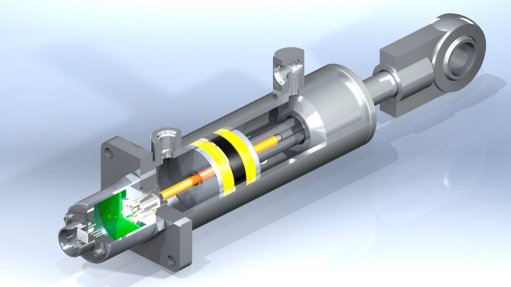
LVIT The in-cylinder sensor is an easily installed cost effective solution for measuring resonant frequency in hydraulic cylinders
Recent electronic advancements have made variable inductance position sensors, known as linear variable inductance transducers (LVITs) more cost effective for mainstream in-cylinder applications, says specialised sensor manufacturer Alliance Sensors Group (ASG), a division of HG Schaevitz.
ASG CEO Harold Schaevitz says the contactless technology of LVITs offers significant advantages in terms of product life and long-term reliability, compared with those of its competitors, and performs favourably in specifications, such as nonlinearity, resolution, and frequency response.
He notes that the sensors can withstand hostile shock and vibration environments, such as those commonly found in heavy industrial and mobile equipment applications for cylinders, commonly used in earthmoving equipment.
The sensors measure the resonant frequency of an oscillator using a simple inductive probe, with its inductance varied by the position of the surrounding conductive tube or gun-drilled rod. The oscillator frequency is digitally processed and converted to an analogue output.
MR-7, MHP-7 and ME-7 Series
In-cylinder LVITs are typically offered in full-scale ranges from 100 mm to 900 mm, in port-mounted or internally embedded packages, with either connector or cable terminations.
As LVITs are contactless solutions, they do not require machining a cavity in the cylinder piston for a ring magnet of a magnetostrictive sensor or wiper contact of a potentiometer.
These sensors produce an analogue direct-current voltage or current output, with a digital output available for original-equipment manufacturer (OEM) applications.
Meanwhile, a proprietary remote field calibration called SenSet is a standard feature that enables a user to scale the analogue output of the sensor after it has been installed in the cylinder, making it unnecessary to scale the unit in an actual control system.
Schaevitz notes that, in the past few years, requirements for instrumented cylinders have dramatically increased. Consequently, LVITs are now available in a pressure-sealed version that enables a user to install the sensor and cylinder in external environments, such as seawater at depths of 3 650 m with about 3 000 psi of internal hydraulic pressure.
While these LVITs are designed for subsea applications, such pressure-sealed LVITs perform suitably with production drills or shaft sinking equipment in underground environments, he states.
LVITs can also provide spool position feedback for two-stage hydraulic valves. Schaevitz explains that in two-stage proportional spool valves, the output of the pilot stage determines the velocity of the main spool, and that without spool position feedback, the second stage main spool would move immediately to its maximum position, resulting in uncontrolled maximum flow.
Thus, main spool position feedback permits the pilot stage to control the position of the second stage and thereby controls the spool valve’s output flow.
He adds that “the short-range port-mounted MHP-7 Series LVIT . . . is almost always an easier and lower-cost installation than a pressure-sealed linear variable differential transformer (LVDT), which requires an isolation tube to seal off its windings from the valve’s pilot pressure and relatively expensive electronics”.
LV-45 Series
For mining applications better suited to an externally mounted position sensor, the LV-45 LVIT series is specifically designed for applications requiring “rugged” devices capable of operating in extreme environments. It has also been installed at paper mills, in turbines and in off-road construction vehicles.
The LV-45 has a simple coil design, a 12.7-mm-diameter connecting rod and a 45 mm thick-walled housing, making it shorter and more robust than its LVDT counterparts. Additionally, unlike its competitors, it can operate within a temperature range of between –40 C and 85 °C.
About ASG
ASG offers linear and rotary position sensors for industrial measurement applications, supplying OEMs, as well as the industrial automation, power generation, military and special manufacturing industries.
Its standard product line features LVIT linear position sensors, as well as LVDTs, rotary sensors and sensor support electronics. In addition to their standard products, it can design and build custom position sensors to meet client specifications.
ASG develops and markets innovative sensors and related electronics to serve the design engineers who create automation and/or testing systems for manufacturing, energy production, industrial and mobile hydraulics, research and development, and laboratory testing.